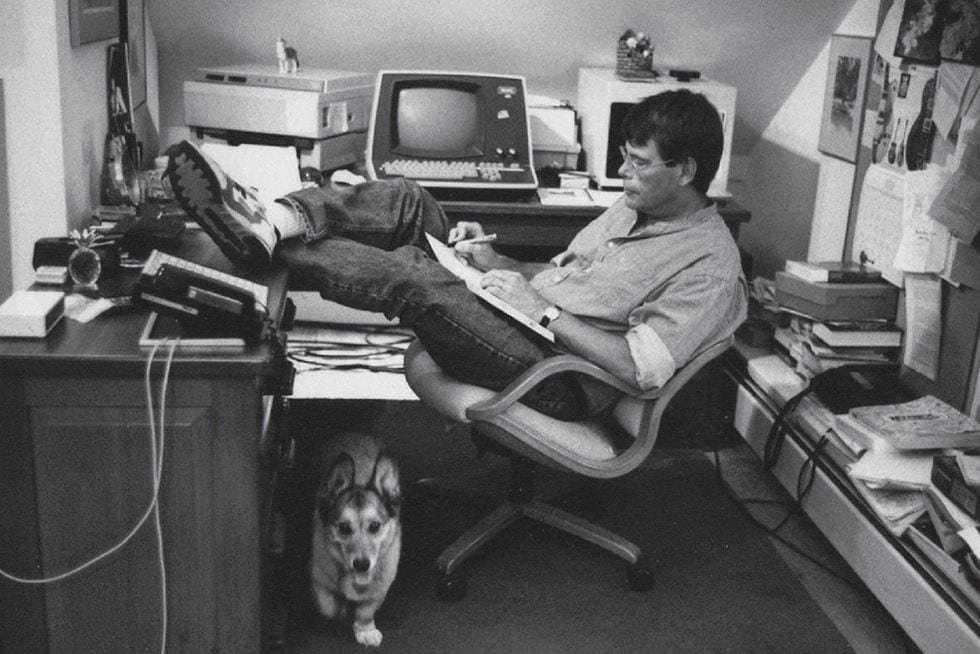Had the fates conspired to place writer Stephen King walking on the shoulder of Maine State Route 5 on 19 June 2019, at approximately 4:30PM, (rather than the actual time of 20 years earlier), the physical consequences would probably have been the same. He is walking his usual four miles a day, as he writes in his 2000 book On Writing: A Memoir of the Craft (Scribner, 2010). He and his family are at their summer home in western Maine. In crisp terms, he explains what happens when distracted driver Bryan Smith comes over the crest where King’s walking: “He wasn’t on the road; he was on the shoulder. My shoulder. I had perhaps three-quarters of a second to register this.” King tries to get out of Smith’s way, but he’s too late. He looks down at his body and notes: “…my lap now appears to be on sideways, as if my whole lower body had been wrenched half a turn to the right.”
The extensive recollection of this accident runs a little over 3,300 words, approximately eight single-spaced pages. It comes near the end of On Writing, a book told in four parts. The first is called “C.V.”, and stands as an appropriate accounting of his life and times. King had long been at the top of the world as a popular horror novelist. Carrie was a quarter-century old. Most all the subsequent titles through 1999, including 1977’s The Shining, 1979’s The Dead Zone, and 1983’s Pet Sematary, were adapted (to varying degrees of success) into big-screen films and TV mini-series. Fans followed every step of the pulp, the obsessed characters, the doomed premises, and the interwoven universe he was creating. Popular success was measured in book sales and the willingness readers felt to surrender themselves and absorb what was about to happen. Some of the plots might have been stale and predictable and some of the titles might have benefitted from extensive editing, but that didn’t matter.
What worked best in the first quarter of On Writing was the patience King displayed. He might have appeared to be publishing at a fever pitch for 25 years (37 titles under his name and as Richard Bachman), but he was in no rush. This book was about time. There’s the 1971 marriage to Tabitha, starting a family, publishing stories in adult men’s magazines. There’s life as a high school English teacher as he begins his work on Carrie, but of course that was only the first novel he published. How, where, and why these novels originated proves of interest to fans of the genre, but more gripping in this part of On Writing is King’s understanding of his alcoholism:
“Alcoholics build defenses like the Dutch build dikes. I spent the first twelve years of my married life assuring myself that I ‘just liked to drink.'”
Drug addiction joins alcoholism by 1985, and King surrenders to his condition. “I had forgotten the trick of being straight…” he writes. When King ends this first part with a discussion of his writing desk and the importance of its placement in his room, the reader connects his thoughts with Virginia Woolf’s A Room of One’s Own. Both writers were focusing on identity and place, but King understood writing wasn’t the alpha and omega of life. Put your desk in the corner, “and every time you… write, remind yourself why it isn’t in the middle of the room. Life isn’t a support system for art. It’s the other way around.”
King officially introduces himself to us in the next section, “What Writing Is”, at only five pages. Of course, the reader can’t help enjoy the humor in the fact that this writer, so prone to over-indulgence in some of his epic novels, chooses clarity when trying to define the craft. This is important to note. King is not really defining his work so much as he’s identifying elements of the craft. Of writing, he emphasizes: “If you can take it seriously, we can do business. If you can’t or won’t, it’s time for you to close the book and do something else.” In the section called “Toolbox”, King gets deep into the weeds of word choices, adherence to grammar, and style. The ride is understandable both for the fan of the purely popular and the academic student of the craft. King defends the task of building the epic:
“Is there any rationale for building entire mansions of words? I think there is… sometimes it’s beautiful and we fall in love with all that story…W e are talking about tools and carpentry… words and style… we are also talking about magic.”
The modern reader who might be unwilling to go along with King on this magic carpet ride may feel frustrated at his immediate willingness to surrender to magic (let alone acknowledge it). He acquits himself a few pages later as he starts the title section. He submits two theses for our consideration. In the first, it’s all about mastering fundamentals of grammar, style, and the best instruments for the job. The second thesis suggests that it is possible “…to make a good writer out of a merely competent one.” In other words, King stresses competency above everything. The magic a good writer brings to any project will result in consequences that vary in degrees of success, but it will be nowhere without competency. The good writer needs to read and read and read again. Of book consumers, King writes that they “…want a good story to take with them on the airplane.” Populism over artistic credibility has always been easy to dismiss, but it’s hard not to side with King here. We read to learn and we read to escape.
King writes that there are three parts to stories and novels: narrative, description, and dialogue. He writes: “…my basic belief about the making of stories is that they pretty much make themselves.” It’s a difficult claim to make, let alone support, and while King explains himself, the reader will be excused if impatience comes into their appreciation of this book. It isn’t that his support isn’t valid. One line stands out: “Story is honorable and trustworthy; plot is shifty, and best kept under house arrest.” The problem here probably comes from a reader’s perspective. Spend all your time in the Ivory Towers swimming through volumes of Henry James and Marcel Proust and you will demand plot. Keep a foot in the real world and you will simply enjoy a good story.
King writes in detail about his experiments with theme in The Stand, and the reader familiar with that early epic masterpiece will appreciate the effort. In a book whose main enemy was a plague that devastated the world, King saw the effect it was having on the essence of his story. He writes: “…the world of my story had become dangerously overcrowded… the solution… an explosion instead of a plague… violence as a solution is woven through human nature like a damning red thread. That became the theme of The Stand…” We need the ideal reader. We strive for a sense of pace and rhythm. We write and re-write and still there are elements left unsaid. In 1990 King released an expanded edition of The Stand that might have been inconsistent with the classic writing tip “Kill your darlings”, (which is absent in On Writing), but it met the needs of a rabid fan base.
The final section of On Writing, called “On Living: A Postscript”, features a recollection of the accident, and the reader of 2019 is likely to be as amazed as the reader first encountering this in 2000. It’s brutal and explicit as we read King thinking that driver Bryan Smith seemed one of his nightmare visions brought to life. “I have nearly been killed by a character right out of one of my own novels,” he writes. “It’s almost funny.” He notes that he actually began writing On Writing in 1997, put it aside for a while, and was determined to finish it that summer of 1999. After the accident, “I didn’t want to go back to work,” he writes. “…[H]ow was I supposed to write about dialogue, character, and getting an agent when the most pressing thing in my world was how long until the next dose of Percocet?”
Of course, Stephen King survived the crash and has produced even more material in the subsequent 20 years. Bryan Smith, ten years his junior, was found dead of an accidental fentanyl overdose on 21 September 2000, King’s 53 rd birthday. On Writing was published in October 2000. The reader encountering a first edition of this book at the time of its initial release might have read about Smith’s demise, but that was the extent of the information provided. Smith is a footnote forever connected to King but since relegated to the dark corners of a backwoods Maine resident who never got away from the downward spiral of his life until it ended.
Again, had King and Smith met on that same street on 19 June 2019, the physical consequences would have probably been complicated by media drones, TMZ helicopters, Instagram and Twitter posts, and Facebook livestream coverage. American Horror Story schlockmaster co-creator Ryan Murphy would probably have bought the rights to the story and featured it in a ten-episode limited TV series event for FX. Instead, it lives best in the final section of On Writing.
In effect, the greatest success of this book and the final event that serves as its grim epilogue is that King retained control of the narrative. Reading this book now, in a world of dangerously short attention spans and constantly distracted consumers of product, the strength of King’s commitment to his craft and hope that it will be perpetuated cannot help but have a wondrous, supernatural, effect. On Writing is about creation, recovery, humility, and persistence. It’s about the precarious promise all readers must make to absorb all manner of great books; filter it through their own sensibilities, and make their own masterpieces. In a world where bookstores are dying and libraries surrendering to streaming services for literary, audio, and video entertainment, On Writing is even more important to re-read and appreciate.




